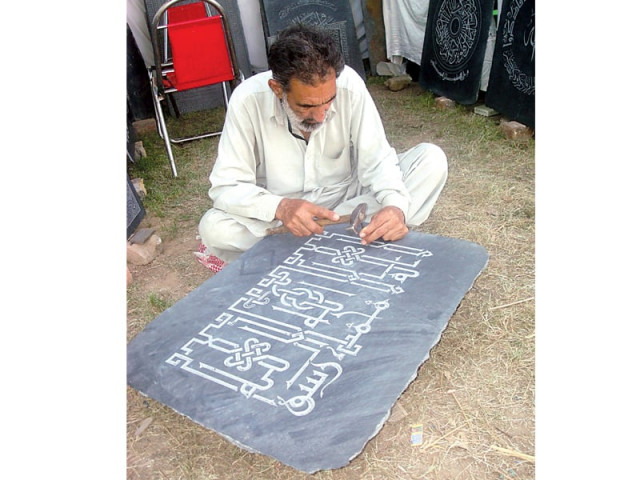Festivities galore: Ethnic extravaganza: K-P pavilion unveils rich heritage
Aristans and performers rekindle the essence of the province.

A stone-carver displaying his work at the festival. PHOTO: EXPRESS
As mercury rises, culture enthusiasts are thronging Lok Mela (festival) to take in the sights, sounds and smells of different provinces.
In keeping with the traditional spirit, each province has set up their pavilions presenting indigenous folk music, songs, dances and cuisine peculiar to their respective areas at the colourful pavilions, said a press release.
K-P pavilion has its own charm. The replica of ‘Bab-e-Khyber’ as entrance to the pavilion stands tall with its grandeur. The pavilion boasts of 20 diverse master craftspersons from different parts of the province. “The K-P pavilion truly represents the cultural identity of the brave people of the province. It gives a message to the world that they are peace-loving people with an incredible heritage. Their hospitality is matchless,” said Nafisa Mir, a university student.
Farhat Bibi from Dera Ismail Khan is prominent among the female artisans. She is the master artisan of wood lacquer work. The word ‘lack’, ‘lac’, ‘leca’ or ‘laksha’ in different languages is significantly derived from the Persian word ‘lac’ or Hindi word ‘lakh’ meaning a hundred thousands.
Locally, it is called ‘jundri’ or ‘jandi ka kaam’, which forms an intrinsic part of three provinces of Pakistan, involves the process of applying layers of ‘lac’ in different colours on wood, while the material is rotated on a simple wooden lathe machine. Patterns are etched with the help of thick iron needle on the surface, exposing each colour according to the requirements of traditional patterns.
Meanwhile, Mohammad Ilyas’s forte is wood carving. He carves intricate designs, figurines and scenery with free hand - without tracing patterns on a piece of wood. He also procures wooden furniture liked by foreigners as well as local art lovers.
Visitors at pavilion are also devouring ‘chappal kababs’. The aroma of the food becomes tempting and irresistible and you cannot help but settle down for a portion or two of this delicacy. The pavilion also offers other traditional food like ‘patta seekh’ and ‘lamb karahi’ all washed down with a cup of ‘qehwa’ (green tea) wit a hint of cardamom being brewed in ‘samovar’ at Nemat Khan Qehwa Khana.
In close proximity, a ‘hujra’ has been created wherein musicians are presenting folk Pashto music “Tank Takor” whilst playing traditional musical instruments like ‘rubab’, tabla and harmonium.
Published in The Express Tribune, April 17th, 2013.













COMMENTS
Comments are moderated and generally will be posted if they are on-topic and not abusive.
For more information, please see our Comments FAQ